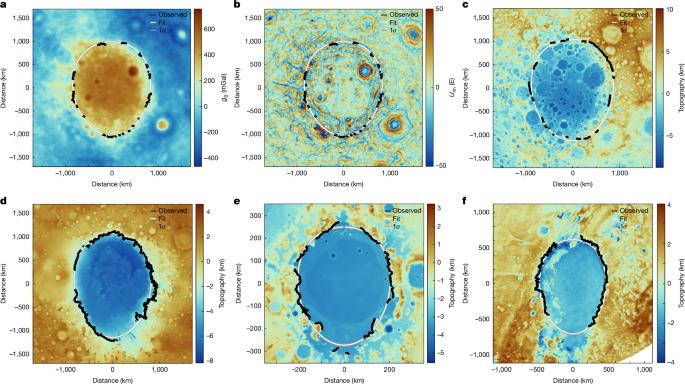月球南极-艾特肯盆地南向撞击形成岩浆海
IF 48.5
1区 综合性期刊
Q1 MULTIDISCIPLINARY SCIENCES
引用次数: 0
摘要
古老的南极-艾特肯撞击盆地为我们了解月球的演化提供了一个关键的数据点,因为它形成于月球历史上最早的前nectarian时代1,比任何其他已知的撞击盆地挖掘得都深2,3,并且发现于月球的远侧,对远侧的了解比探索得很好的近侧少。在这里,我们表明,盆地轮廓逐渐变细,地形和地壳厚度逐渐向南转变,支持了向南的撞击轨迹,与通常的假设相反。盆地西南部广泛的富钍富铁喷射物矿床与部分晚期岩浆海洋液体的挖掘相一致。这些观测结果表明,在撞击发生时,富钍岩浆海洋液体只存在于盆地的西南半部分下方,这与从全球岩浆海洋到近侧Procellarum KREEP地体中钾、稀土元素和磷(KREEP)局部富集的过渡预测相吻合。这些结果对即将到来的人类对阿尔忒弥斯月球南极的探索具有重要意义,因为拟议的着陆点现在被认为位于盆地的下边缘和富含钍的撞击喷射物上。对月球南极-艾特肯撞击盆地的形状、地形、地壳厚度和表面组成的观测表明,撞击轨迹是向南的,地壳下有一个不连续的残余岩浆海洋被挖掘出来。本文章由计算机程序翻译,如有差异,请以英文原文为准。

Southward impact excavated magma ocean at the lunar South Pole–Aitken basin
The ancient South Pole–Aitken impact basin provides a key data point for our understanding of the evolution of the Moon, as it formed during the earliest pre-Nectarian epoch of lunar history1, excavated more deeply than any other known impact basin2,3 and is found on the lunar far side, about which less is known than the well-explored near side. Here we show that the tapering of the basin outline and the more gradual topographic and crustal thickness transition towards the south support a southward impact trajectory, opposite of that commonly assumed. A broad thorium-rich and iron-rich ejecta deposit southwest of the basin is consistent with partial excavation of late-stage magma ocean liquids. These observations indicate that thorium-rich magma ocean liquids persisted only beneath the southwestern half of the basin at the time of impact, matching predictions for the transition from a global magma ocean to a local enrichment of potassium, rare-earth elements and phosphorus (KREEP) in the near-side Procellarum KREEP Terrane. These results have important implications for the upcoming human exploration of the lunar south pole by Artemis, as proposed landing sites are now recognized to sit on the downrange rim and thorium-rich impact ejecta of the basin. Observations of the shape, topography, crustal thickness and surface composition of the South Pole–Aitken impact basin on the Moon suggest a southward impact trajectory and the excavation of a discontinuous remnant magma ocean from beneath the crust.
求助全文
通过发布文献求助,成功后即可免费获取论文全文。
去求助
来源期刊

Nature
综合性期刊-综合性期刊
CiteScore
90.00
自引率
1.20%
发文量
3652
审稿时长
3 months
期刊介绍:
Nature is a prestigious international journal that publishes peer-reviewed research in various scientific and technological fields. The selection of articles is based on criteria such as originality, importance, interdisciplinary relevance, timeliness, accessibility, elegance, and surprising conclusions. In addition to showcasing significant scientific advances, Nature delivers rapid, authoritative, insightful news, and interpretation of current and upcoming trends impacting science, scientists, and the broader public. The journal serves a dual purpose: firstly, to promptly share noteworthy scientific advances and foster discussions among scientists, and secondly, to ensure the swift dissemination of scientific results globally, emphasizing their significance for knowledge, culture, and daily life.
 求助内容:
求助内容: 应助结果提醒方式:
应助结果提醒方式:


